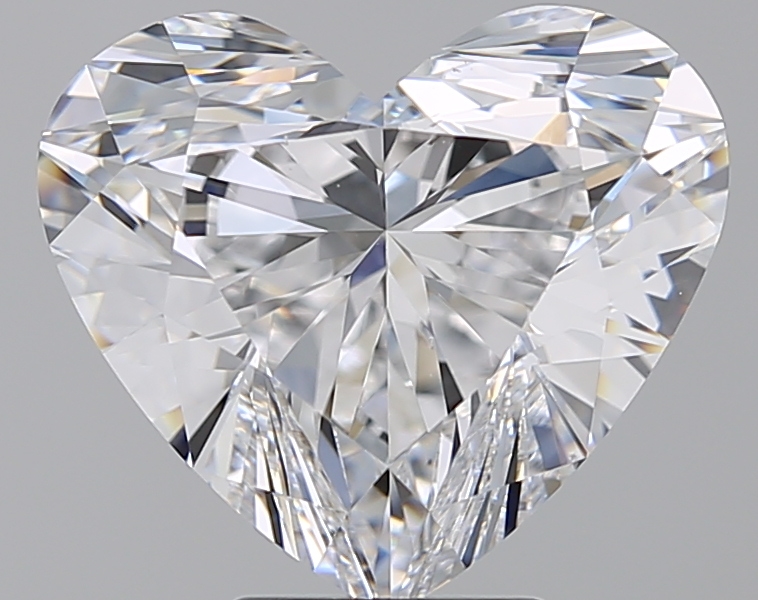The Symbol of Love in Diamond Shape
The heart cut is one of the most romantic and symbolic diamond shapes, often chosen for engagement rings, pendants, and other special jewellery as it represents love and affection. It is a modified brilliant cut, which means that it is based on the traditional round brilliant cut, but with a distinct cleft at the top and a tapering point at the bottom, creating the unmistakable shape of a heart.
Features of the Heart Cut Diamond
The heart cut diamond is unique due to its distinctive heart shape, combining rounded and pointed elements in a single stone. This cut’s elegance and symbolism make it a popular choice for meaningful gifts and milestones.
Key Characteristics:
Cleft at the Top – The heart shape features a cleft or indentation at the top, which divides the diamond into two equal lobes, creating the upper, rounded parts of the heart.
Tapering Point – The bottom of the heart cut tapers into a sharp, pointed end, symbolising the arrow of Cupid or the pointed direction of love.
Balanced Proportions – The heart should maintain a balanced symmetry between the two lobes at the top and the pointed tip at the bottom to ensure the heart shape appears well-formed and even.
The Heart Cut Diamond: A Symbol of Love and Romance
The heart-shaped diamond is the ultimate symbol of romantic love, making it a popular choice for those seeking to commemorate a relationship. Its sentimental value is often just as important as its physical appearance. Whether it is used for an engagement ring or anniversary gift, the heart shape carries with it an undeniable sense of emotion and devotion.
Symbolism of the Heart Cut:
The heart shape represents eternal love and affection, making it one of the most meaningful choices for gifting.
The heart cut’s cleft and pointed end also evoke the imagery of Cupid’s arrow, a timeless symbol of love and passion.
Proportions and Symmetry in the Heart Cut Diamond
The shape and symmetry of a heart cut diamond are essential in determining its overall beauty and visual appeal. The heart shape is one of the more complex diamond cuts, requiring a high level of skill to ensure its proportions are perfect.
Key Proportions:
Symmetry of the Two Lobes – The two rounded lobes at the top of the heart should be even and symmetrical to each other, without any noticeable disparity in size. Any irregularity in the shape can make the heart appear uneven and distort its visual appeal.
Tapering Point – The pointed end should be sharp and centred, not too wide or too thin. A well-shaped heart cut will have a graceful taper that leads to a balanced and harmonious appearance.
Length-to-Width Ratio – The ideal length-to-width ratio for a heart cut diamond is typically between 1.00 and 1.05. This ensures that the heart looks balanced, neither too elongated nor too rounded.
Symmetry and Cut Quality
A high-quality heart cut diamond will be well-symmetrical, with both sides of the heart being mirror images of each other. Imperfect symmetry can make the heart look misaligned or even more like a rounded marquise rather than a true heart shape. Therefore, when evaluating a heart-shaped diamond, symmetry is one of the most important factors to consider.
Light Performance and Sparkle
Like other brilliant cuts, the heart-shaped diamond benefits from its facet arrangement, which helps it to reflect light brilliantly. The symmetry and quality of the cut significantly impact how well the diamond sparkles and how the facets interact with light.
Brilliance and Fire
A well-cut heart diamond will exhibit brilliance (white light reflection) and fire (the dispersion of coloured light). These qualities are enhanced by the facets of the diamond, which are strategically designed to maximise light reflection.
A poorly cut heart shape, however, can result in a dull appearance, with light not being properly reflected or dispersed.
Choosing a Heart Cut Diamond: Considerations
When selecting a heart-shaped diamond, it is crucial to consider factors such as cut quality, clarity, colour, and carat weight, all of which can impact the appearance of the stone.
1. Cut Quality
Cut quality is of the utmost importance for a heart-shaped diamond, as it dictates how well the stone will perform in terms of sparkle and symmetry. A well-cut heart will show excellent light performance and exhibit the clean, defined heart shape.
2. Clarity
Since the heart-shaped diamond has many facets, it can sometimes reveal inclusions and blemishes more clearly than other shapes. Therefore, it is recommended to choose a diamond with a higher clarity grade, such as VS1 or VS2, to ensure that any imperfections do not affect the diamond’s visual appeal.
3. Colour
The colour of a heart-shaped diamond should also be considered, as the cut of the stone can make any colour variations more noticeable. A diamond with a colour grade of G or above is ideal for achieving a bright, white appearance in the heart cut.
4. Carat Weight
The carat weight of a heart-shaped diamond will affect its overall size and visual impact. Since heart-shaped diamonds are often used in statement jewellery, choosing a larger carat weight can help the heart shape appear more prominent.
Setting a Heart Cut Diamond
The heart shape’s romantic appeal makes it a popular choice for engagement rings, pendants, and earrings. When selecting a setting for a heart cut diamond, the design should complement the symbolism and shape of the stone.
Engagement Rings
Solitaire settings allow the heart shape to be the focal point, drawing attention to the unique shape and romantic significance.
A halo setting can enhance the heart’s appearance by making it look larger and more dazzling, as the surrounding smaller diamonds create a stunning contrast.
Other Jewellery
The heart shape is often used in pendants, where the diamond can be the focal point of a delicate chain, or in earrings to create a cohesive set that represents love.
